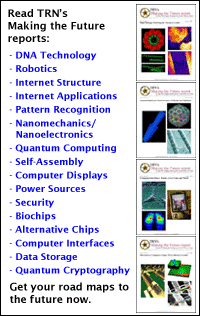
Morphing DNA makes motor
By Kimberly Patch, Technology Research NewsDNA molecules are prime candidates for helping humans make microscopic machines because they have a long history of assembling things on the molecular scale. Every one of a human's 75 to100 trillion cells exists because a DNA molecule automatically unzipped, created the duplicate a cell needs to divide, then folded itself neatly back up again.
Researchers at New York University have taken a significant step forward in being able to instruct artificial DNA molecules to move in specific ways with a method that allows certain portions of DNA to bind to each other, and then release. This reversible binding method allows for control of the shape of a DNA molecule, or machine.
The researchers demonstrated the mechanism by making a four-step rotary motor out of DNA.
The motor is a four-stranded DNA molecule that, prompted by separate strands of DNA, will go through a mechanical cycle over and over again. Because the process is a reversible cycle, there are no waste products.
The four-stranded DNA molecule is essentially a pair of double helixes of DNA connected at several points along their lengths.
When the researchers add molecules of control DNA to a solution full of the motor molecules, the short, single-stranded control molecules join with the larger molecules and rearrange them by connecting two of the double strands in one place and cutting them in another. The researchers then remove the control strands using fuel strands of DNA, which are also short single-stranded lengths of DNA. This leaves the motor molecule in a different physical shape than when it started -- the end of one double strand of the DNA is rotated 180 degrees relative to the strands next to it.
The process can be reversed by adding a different type of control strand to the solution, and that control strand can also be removed by a different type of fuel strand after it changes the molecule back. "The system can be cycled numerous times... and there are no breakdown products," said Nadrian Seeman, a chemistry professor at New York University.
The process can be adapted to many different sequences of DNA, said Seeman. "Many different species of this device can be made by changing the sequences in the region where the... strands bind," he said.
This means a wide range of similar rotary devices can be created by changing the fuel strands and the places where they bind, he said. Ten different molecules can result in 1,024 different structures, for instance.
The researchers are currently working on a method to insert the DNA devices into molecular lattices, said Seeman. This would enable still more structures. An array of four by four molecules, for instance, could produce 65,536 different shapes. "This may enable us to build nanofabrication facilities to produce new molecular species," he said.
The range of motion the molecular motors can produce ranges from .04 to 4 nanometers, but the researchers have produced motions as large as 35 nanometers using arrays, according to Seeman. A nanometer is one millionth of a millimeter. On this scale, an E. coli bacterium is a relative giant, with a girth of 1 micron, or 1,000 nanometers. A line of ten carbon atoms measures about one nanometer.
The research is "great stuff," said Erik Winfree, an assistant professor of computer science and computation and neural systems at the California Institute of Technology. The method is a step forward in terms of DNA mechanics, he said. "It expands our toolbox for designing molecular machines."
The research is ultimately aimed at making nanorobotics practical, according to Seeman. "It could be used to configure a molecular pegboard or control molecular assemblers. The ability to achieve many different shapes means that you can create many different patterns; different patterns in a timed sequence are the essence of a machine or robot," he said.
Molecular machines could be used to assemble drugs molecule-by-molecule, and molecular robots may eventually work inside the human body.
It will be about a decade before the method can be used to make practical devices, said Seeman.
Seeman's research colleagues were Hao Yan, Xiaoping Zhang and Zhiyong Shen. They published the research in the January 3, 2002 issue of Nature. The research was funded by the National Science Foundation (NSF), Office of Naval Research (ONR), the National Institutes of Health (NIH) and the Defense Advanced Research Projects Agency (DARPA).
Timeline: 10 years
Funding: Government
TRN Categories: Biological, Chemical, DNA and Molecular Computing; Nanotechnology
Story Type: News
Related Elements: Technical paper, "A Robust DNA Mechanical Device Controlled by Hybridization Topology," Nature, January 3, 2002.
Advertisements:
January 16, 2002
Page One
Morphing DNA makes motor
Toolset teams computers to design drugs
Atom clouds ease quantum computing
Web pages cluster by content type
Quantum effect alters device motion

News:
Research News Roundup
Research Watch blog
Features:
View from the High Ground Q&A
How It Works
RSS Feeds:
News
Ad links:
Buy an ad link
| Advertisements:
|
 |
Ad links: Clear History
Buy an ad link
|
TRN
Newswire and Headline Feeds for Web sites
|
© Copyright Technology Research News, LLC 2000-2006. All rights reserved.